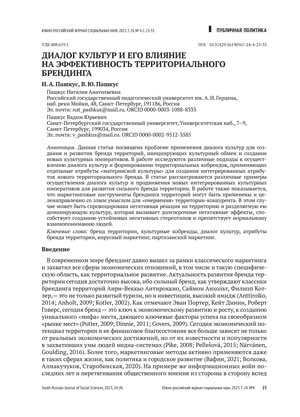Abstract
This paper focuses on using the dialog of cultures to create and develop the brand of territories that promote cultural exchange and establish new cultural imperatives. The article explores different methods for implementing the dialog of cultures and creating territorial co-brands by utilizing unique characteristics of the ‘mother culture’ to form integrated attributes of a new territorial brand. The article examines different cases of implementing the dialogue of cultures and promoting new integrated cultural imperatives to develop a strong territorial brand. The paper shows that territorial branding tools can be used maliciously to defame a competitor’s territory. In this case, a negative reaction to the territory and its dominant culture can be provoked, leading to long-term negative effects. This can contribute to the creation of stable negative stereotypes and hinder mutual understanding.
Keywords
References
- Anholt, S. (2007). Competitive Identity: The New Brand Management for Nations, Cities and Regions. London: Palgrave Macmillan.
- Anholt, S. (2009). Places: Identity, Image and Reputation. London: Palgrave Macmillan.
- Anttiroiko, A.-V. (2014). The Political Economy of City Branding. London: Routledge.
- Avraham, E., Ketter, E. (2012). Media Strategies for Marketing Places in Crisis. London: Routledge.
- Bowen, J., Whalen, E. (2017). Trends that are Changing travel and Tourism. Worldwide Hospitality and Tourism Themes, 9(6), 592–602.
- Braun, E., Kavaratzis, M., Zenker, S. (2013). My city — my brand: the role of residents in place branding. Journal of Place Management and Development, 6 (1), 18–28.
- Budko D. A., Volkova A. V., Kulakova T. A. (2022). Tsifrovoy vigilantizm: ekonomicheskiy rakurs. [Digital Vigilantism: an Economic Perspective]. Problemy sovremennoy ekonomiki [Problems of the Modern Economy], 1, 83–87.
- Dinnie, K. (2011). City Branding: Theory and Cases. London: Palgrave Macmillan.
- Florek, M., Kavaratzis, M. (2014). From Brand Equity to Place Brand Equity and from There to the Place Brand. Place Branding and Public Diplomacy, 10, 103–107.
- Foroudi, P., Gupta, S., Kitchen, Ph. J., Foroudi, M. M. (2016). A Framework of Place Branding, Place Image, and Placereputation: Antecedents and moderators. Qualitative Market Research: An International Journal, 19(2), 241–264.
- Govers, R. (2009). Place Branding: Glocal, Virtual and Physical Identities, Constructed, Imagined and Experienced. London: Palgrave Macmillan.
- Kavaratzis, M., Hatch, M. J. (2013). The Dynamics of Place Branding: an Identity-based Approach to Place branding Theory. Marketing Theory, 13(1), 69–86.
- Kotler, P., Gertner, D. (2002). Country as Brand, Product, and Beyond: a Place Marketing and Brand Management Perspective. Journal of Brand Management, 9(4–5), 249–261.
- Massey, G., Kliestikova, J., Kovacova, M., Dengov, V. V. (2018). The Perceived Accuracy of Fake News: Mechanisms Facilitating the Spread of Alternative Truths, the Crisis of Informational Objectivity, and the Decline of Trust in Journalistic Narratives. Geopolitics, History and International Relations, 10(2), 37–43.
- Medway, D., Warnaby, G. (2008). Alternative Perspectives on Marketing and the Place Brand. European Journal of Marketing, 42(5/6), 641–653.
- Närvänen, E., Goulding, Ch. (2016). Sociocultural Brand Revitalization: The Role of Consumer Collectives in Bringing Brands Back to Life. European Journal of Marketing, 50 (7/8), 1521–1546.
- Pellešová, P. (2015). Tourism and multiplication effects in the region. In Business Information Management Assoc., 515–520.
- Pike, St. (2008). Destination Marketing: An Integrated Marketing Communication Approach. Oxford: Butterworth-Heinemann.
- Potter, E.H. (2009). Branding Canada. Projecting Canada’s soft power through public diplomacy. Montreal: McGill-Queen`s Univ. Press.
- Richards, G. (2018). Cultural tourism: A Review of Recent Research and Trends. Journal of Hospitality and Tourism Management, 36, 12–21.
- Schroeder, J. E. (2014). Brands: Interdisciplinary Perspectives. London: Routledge.
- Vafin, A. M. (2021). Negativ v politike: 10 tekhnologiy “chernogo” PR v Rossii i zarubezhnykh stranakh. [Negativity in Politics: 10 Technologies of “Black” PR in Russia and Foreign Countries]. Voprosy politologii [Questions of Political Science], 1(65), 107–114.
- Volkova, A. V., Almakuchukov K. M., Starobinskaya N. M. (2020). Novyye tekhnologii gorodskogo razvitiya i upravleniye art-rynkom: opyt Sankt-Peterburga. [New Technologies of Urban Development and Management of the Art Market: The Experience of Saint-Petersburg]. Problemy sovremennoy ekonomiki [Problems of modern economics], 1, 173–176.
- Zhang, H., Wu, Y., Buhalis, D. (2018). A Model of Perceived Image, Memorable Tourism Experiences and Revisit Intention. Journal of Destination Marketing & Man, 8, 326–336.
 Русский
Русский


